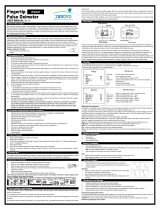
42
9 APPENDIX
A - Common Knowledge for SpO2 Measurement
1 Meaning of SpO2
SpO2 is the saturation percentage of oxygen in the blood, so called O2 concen-
tration in the blood; it is dened by the percentage of oxyhemoglobin (HbO2) in
the total hemoglobin of the arterial blood. SpO2 is an important physiological
parameter to reect the respiration function; it is calculated by the following
method: SpO2 = HbO2/ (HbO2 + Hb)×100%
HbO2 are the oxyhemoglobins (oxygenized hemoglobin), Hb are those hemo-
globins which release oxygen.
2 Principle of Measurement
Based on Lamber-Beer law, the light absorbance of a given substance is di-
rectly proportional with its density or concentration. When the light with certain
wavelength emits on human tissue, the measured intensity of light after ab-
sorption, reecting and attenuation in tissue can reect the structure character
of the tissue by which the light passes. Due to that oxygenated hemoglobin
(HbO2) and deoxygenated hemoglobin (Hb) have different absorption character
in the spectrum range from red to infrared light (600nm~1000nm wavelength),
by using these characteristics, SpO2 can be determined.
SpO2 measured by this oximeter is the functional oxygen saturation -- a per-
centage of the hemoglobin that can transport oxygen. In contrast, hemoxime-
ters report fractional oxygen saturation – a percentage of all measured hemo-
globin, including dysfunctional hemoglobin, such as carboxyhemoglobin or
metahemoglobin.
Clinical application of pulse oximeters: SpO2 is an important physiological pa-
rameter to reect the respiration and ventilation function, so SpO2 measure-
ment used in clinical becomes more popularly, such as monitoring the patient
with serious respiratory disease, the patient under anesthesia during opera-
tion, premature and neonate. The status of SpO2 can be determined in time
Trouble Possible Reason Solution
Always display
“No Signal” 1. The probe is not connect-
ed to the oximeter properly.
2. The nger is not placed
well.
3. The probe connector or the
probe sensor is broken.
1. Connect the probe
to the oximeter properly
and try again.
2. Place the nger properly
and try again.
3. Please contact the local
service center.
ENGLISH





















